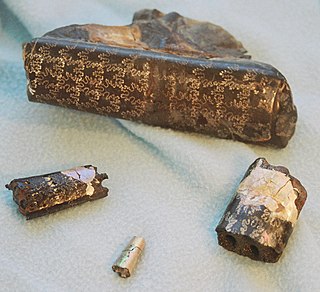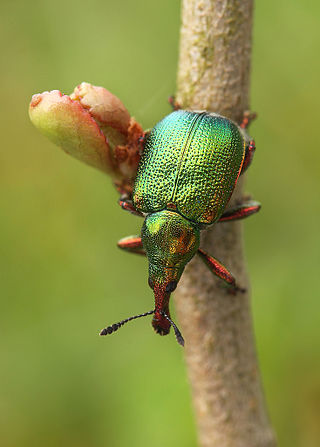
Baculites is an extinct genus of heteromorph ammonite cephalopods with almost straight shells. The genus, which lived worldwide throughout most of the Late Cretaceous, and which briefly survived the K-Pg mass extinction event, was named by Lamarck in 1799.

Styracosaurus is an extinct genus of herbivorous ceratopsian dinosaur from the Late Cretaceous of North America. It had four to six long parietal spikes extending from its neck frill, a smaller jugal horn on each of its cheeks, and a single horn protruding from its nose, which may have been up to 60 centimeters long and 15 centimeters wide. The function or functions of the horns and frills have been debated for many years.

Psidium cattleyanum , commonly known as Cattley guava, strawberry guava or cherry guava, is a small tree in the Myrtaceae (myrtle) family. The species is named in honour of English horticulturist William Cattley. Its genus name Psidium comes from the Latin psidion, or "armlet." The red-fruited variety, P. cattleyanum var. cattleyanum, is commonly known as purple guava, red cattley guava, red strawberry guava and red cherry guava. The yellow-fruited variety, P. cattleyanum var. littorale is variously known as yellow cattley guava, yellow strawberry guava, yellow cherry guava, lemon guava and in Hawaii as waiawī. Although P. cattleyanum has select economic uses, it is considered the most invasive plant in Hawaii.

The family Stromateidae or butterfish contains 15 species of fish in three genera. Butterfishes live in coastal waters off the Americas, western Africa and in the Indo-Pacific.

Commissaris's long-tongued bat is a bat species from South and Central America.

Neottia ovata, the common twayblade or eggleaf twayblade, is a terrestrial orchid widespread across much of Europe and Asia

Lagurus is a genus of Old World plants in the grass family, native to the Mediterranean Basin and nearby regions, from Madeira and the Canary Islands to Crimea and Saudi Arabia. It is also naturalized in Australia, New Zealand, the Azores, Ireland and Great Britain, and scattered locations in the Americas. The only known species is Lagurus ovatus, commonly called hare's-tail, hare's-tail grass or bunnytail. It is also grown as an ornamental plant for its attractive flower panicles.

Leptodactylodon ovatus is a species of frog in the family Arthroleptidae. It is found in western Cameroon and extreme eastern Nigeria. Two subspecies are distinguished: Leptodactylodon ovatus ovatus in the westernmost part of the range and Leptodactylodon ovatus orientalis in the east, probably separated by Mount Kupe.

The tooth-nosed snout weevils, Rhynchitidae, are small beetles that are usually found in vegetation. They usually use buds, fruits, or seeds for oviposition. The tooth-nosed snout weevils receive this name due to the teeth on the edges of their mandibles.

Lasiocephalus is a genus of South American flowering plants in groundsel tribe within the sunflower family. The genus was shown to be part of Senecio and predominantly occurs in tropical alpine-like regions.

Ceanothus americanus is a species of Ceanothus shrub native to North America. Common names include New Jersey tea, Jersey tea ceanothus, variations of red root, mountain sweet, and wild snowball. New Jersey tea was a name coined during the American Revolution, because its leaves were used as a substitute for imported tea.

Trachinotus ovatus, the pompano which is also known as the derbio or silverfish, is a species of ray-finned fish in the family Carangidae, the jacks. It has large, strong fins. It is common in the Mediterranean Sea, and in the Atlantic Ocean from the British Isles and Scandinavia, where it is a vagrant, to the Gulf of Guinea and Angola.

Vetufebrus is an extinct genus of haemospororida in the family Plasmodiidae. At the time of its description the new genus comprised a single species Vetufebrus ovatus known from a single Miocene Dominican amber fossil found on Hispaniola. V. ovatus was vectored by Enischnomyia stegosoma, the first fossil streblid bat fly described from a fossil, and the only member of the subfamily Nycterophiliinae described from Hispaniola. V. ovatus is the first instance of a Streblidae bat fly as a host for a malarial parasite.

The Empire Exhibition, South Africa, held in Johannesburg, was intended to mark that city's jubilee and was opened by the Governor-General of the Union of South Africa on 15 September 1936. It was the first exhibition held in the Union of South Africa following two earlier exhibitions in Cape Colony in 1877 and 1892. The idea of an empire exhibition in South Africa was first discussed in 1934 by the Buy Empire Committee of Johannesburg. On 9 January 1935, the Grand Council of the Federation of British Industries passed a resolution for a proposal to hold an Empire Exhibition in Johannesburg in 1936 in conjunction with the Golden Jubilee of the city.
Dolichopus ovatus is a species in the family Dolichopodidae, in the order Diptera ("flies").
Limnichoderus ovatus is a species of beetle in Limnichidae, a family with the vernacular name "minute marsh-loving beetles".

Otiorhynchus meridionalis, the lilac root weevil, is a species of broad-nosed weevil in the family Curculionidae. It is found in North America. Lilac root weevils are shiny, brownish-black beetles, about 0.25 inches (0.6 cm) with long snout (rostrum) and geniculate (elbowed) antennae. They are common landscape pests, feeding on lilac, euonymous and peonies.
Matus ovatus is a species of predaceous diving beetle in the family Dytiscidae. It is found in North America.

Hibiscus aethiopicus is a small, prostrate to semi-erect herbaceous perennial in the family Malvaceae, indigenous to eastern and southern Africa.
Cyperus ovatus is a species of sedge that is native to south eastern parts of North America and some islands of Caribbean.
















